Abstract
It is well known that female labour force participation (FLFP) has a significant contribution to economic growth and wellbeing. This study aims to shed light on the situation of FLFP and per capita GDP of Turkey as an indicator of wellbeing by analysing the trends of both indicators over the years from 1990 to 2019, since both remains low over the years. Moreover, a comparison of the indicators among the European Union (EU), the Organisation for Economic Cooperation and Development (OECD) and Turkey are provided by radar charts to illustrate how the gap between Turkey and the EU and OECD members expanded. Furthermore, the main determinants of the low levels of FLFP in Turkey is gathered from the findings of studies in the literature. The reasons for the low levels of FLFP in Turkey are categorised in five main groups: Fertility, education and skills, the role of housework, globalization, and lastly, religious, cultural and social norms. Policy suggestions are designed accordingly hence.
Keywords: Female Labour Force Participation, Economic Growth
Introduction
There are inequalities existing between males and females all over the world. Global Gender Gap Report states that those inequalities arise in four main categories; as economic participation and opportunity, educational attainment, political empowerment, health, and survival (Hausmann et al., 2009). Although there have been substantial improvements in educational and health categories, the gap between males and females in economic and political categories still remains significantly high necessitating further focus. The low level of female labour force participation (FLFP) is one of the most important issues required to be improved to be able to decrease the gap between males and females in the category of economic participation and opportunity. Moreover, FLFP is not only important for economic growth but also it serves as a proxy for the status of females in society. Furthermore, increased FLFP leads to improved living standards by increasing per capita income. Thus, over the past few decades, there has been an increasing awareness of the significance of FLFP on economic growth both in the academic literature and policy arena. One of the most important proceedings is the action of the post-2015 Sustainable Development Goals (SDGs) through presenting gender-specific goals accompanied by the increased attention on global gender inequality of multilateral organizations particularly concentrating on the low levels of FLFP (The World Bank, 2007, 2012, 2018; IMF, 2013, 2016; OECD, 2008, 2015, 2018, 2020). Despite there have been considerable improvements in FLFP in most developed countries, it still remains low in several developing countries.
Turkey is a developing country located in the Mediterranean, with a per capita GDP of $8,536 (Worldbank, 2021), who is a member of the Organisation for Economic Cooperation and Development (OECD) since 1961 and a candidate for the European Union (EU) since 1999. It is confirmed that the full integration of females into the economy is a necessary target for equity and efficiency concerns. Equity entails the improvement of the relative economic position of females by increased female labour market participation, leading further progress of overall economic efficiency, which in turn improves development possibilities of the country. However, the FLFP in Turkey remains far below the OECD and EU, and even the global averages. Furthermore, per capita GDP of Turkey is even worse, being less than one third of per capita GDP of the EU average which is $30,997 and the OECD average which accounts for $35,838 in 2019 (Worldbank, 2021), Turkey needs to adjust its policies to catch up with the OECD and EU members in both the average FLFP and thus in GDP per capita. Table 1 given below illustrates the per capita GDP, FLFP rates and female to male LFP ratios of Turkey, EU and OECD averages. Changes of the indicators over the years from 1990 and 2019 are also given to illustrate the progresses.
As it is illustrated by Table 1, there is an unnoticeable improvement in FLFP and a slight improvement in female to male LFP ratio in Turkey, as they only increased by 0.67% and 12.7% respectively. When the progress is considered for the EU and OECD members’ averages, it can be seen that there have been significant increases in both indicators. On the contrary, per capita GDP in Turkey increased extensively relative to the increases of EU and OECD average, however it still remains as around one third of the EU and OECD averages.
Since relatively low levels of labour market attainment of females in Turkey is in contradiction with the equity and efficiency targets, this issue deserves severe attention from both the academics and policy makers to stimulate FLFP.
This study is designed to explore the link between FLFP and economic growth as proxied from per capita GDP in six sections. Followed by the introduction, section two provides information on the FLFP and economic growth in Turkey over the years from 1990 to 2019. The third section offers a literature review on the issue, while section four focuses on the empirical analysis of the causal link between the FLFP and per capita GDP in Turkey. The last section concludes the study and summarizes policy recommendations to improve female labour conditions in the labour market of Turkey.
Literature review
There are several studies aiming to investigate the main determinants of FLFP rate and also the impact of FLFP rate on economic growth by employing either time-series data for a specific country analysis or cross-sectional data for a group of countries. Studies of Mincer (1962) and Cain (1966) lead the way to the analysis of the issue in economic literature. Some of those studies’ target is to investigate the validity of the U-shaped hypothesis of female labour force function, stating that FLFP decreases over the early stages of industrialization and starts to increase after a threshold level of development is reached (Altuzarra et al., 2019; Gaddis & Klasen, 2014; Goldin, 1995; Khaliq et al., 2017; Kumari, 2018; Luci, 2009; Tam, 2011; Tansel, 2002; Tsani et al., 2013). On the contrary, there are also studies in the literature aiming to investigate the impact of FLFP on per capita GDP or economic growth (Anyanwu et al., 2021; Bloom et al., 2009; Bryant et al., 2004; Gruen & Garbutt, 2003; Verick, 2014). Moreover, some studies in the literature aims to investigate the causality link between FLFP rate and economic growth (Dursun & Damadoglu, 2020); while others aim to project the possible increase in GDP in general and per capita GDP when the FLFP level of a country reaches a certain level (Braynt et al., 2004; Kalmaz, 2018).
There are several studies in the literature focusing on the position of female labour in the labour market of Turkey. Some of those aim to find the impact of female labour force participation on per capita income or economic growth (Cin et al., 2021); while some are aiming to investigate the validity of the U-shaped hypothesis of female labour force function and the determinants of FLFP in Turkey (Atasoy, 2017; Gaddis & Klasen, 2014; Sinha, 1967; 2011; Tunali et al., 2021; Tsani et al., 2013). Few studies in the literature examined the causal link between economic growth and FLFP rate in Turkey (Budun, 2021; Dursun & Damadoglu, 2020; Mujahid & Zafar, 2012).
Almost all studies in the literature prove the significance of the link between FLFP and economic growth. Furthermore, the positive impact of FLFP on economic growth and development is also confirmed by the literature which shows the importance of increased FLFP in both developed and developing countries.
Trends of per capita GDP in Turkey
Turkey is defined to be an emerging market economy which is one of the newly industrialized countries of the world, with a total population of 83,429,607 and a per capita GDP of $11,956 in 2019 (The World Bank, 2021). Though the leading sector has been the services sector over the years which are focused on this study, shares of the sectors changed over time. Figure 9.1. and Figure 9.2. given below illustrate the distribution of GDP among the sectors for the years 1990 and 2019 respectively.
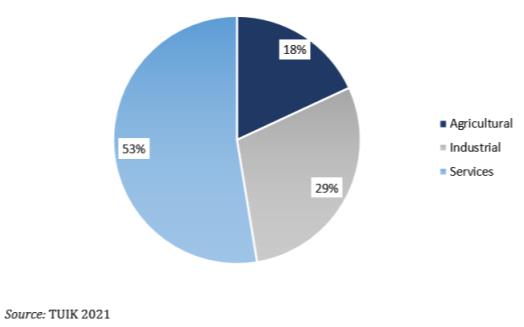
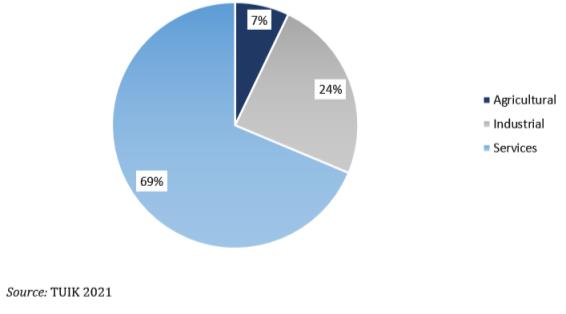
As it can be seen from the figures given above, the share of the services sector in GDP expanded from 1990 to 2019, which confirms that Turkish economy is mostly based on the services sector. There has been a decrease in the share of both agricultural and industrial sectors over the years under consideration. Since the decrease in the share of the industrial sector is not as severe as the decrease in the agriculture sector, it can be stated that Turkish economy experienced a shift from the agricultural to services sector throughout the years. The share of the industrial sector also decreased from 1990 to 2019, but the decrease is not as severe as it is in the share of the agriculture sector.
Economic growth is proxied by using per capita GDP in Turkey over the years from 1990 to 2019. Figure 9.3. given below illustrates the trend of per capita GDP in the EU, OECD and Turkey.
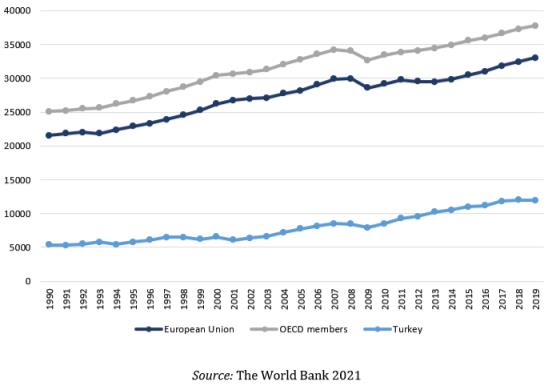
As illustrated by Figure 9.3. above, the per capita GDP over the considered years shows an increasing trend. However, a huge persistent gap exists between the per capita GDP of Turkey and of the OECD and EU all over the years from 1990 to 2019. Furthermore, the existing gap shows an expanding trend. In 1990, the per capita GDP recorded as $21,510, $25,092 and $5,354 in the EU, OECD and Turkey respectively (The World Bank, 2021). It can be concluded that the GDP per capita in Turkey was almost as low as one fourth of the EU average and one fifth of the OECD members’ average. The per capita GDP of Turkey doubled over the years from 1990 to 2019, reaching to $11,956. Nevertheless, the gap between the records of Turkey and of both the EU and OECD enlarged furthermore; since there have been an increasing trend both in the EU and OECD records, accounting for $32,997 and $37,747 correspondingly in 2019. Figure 9.4. given below illustrates the radar chart of the state of Turkey in comparison to the EU and OECD averages for per capita GDP over the years 1990 and 2019, where the increasing gap between the per capita GDP of Turkey and of the EU and OECD can be easily seen.
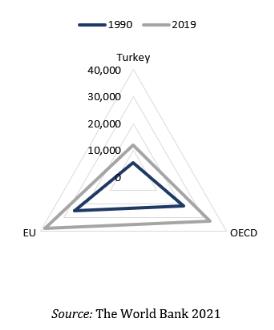
As it can be seen from Figure 9.4., there is not only a long way for Turkey to catch up with the average levels of FLFP, but also with the per capita GDP of the EU and OECD members. It should also be mentioned that the per capita GDP of Turkey is the third lowest of the OECD members, following Colombia accounting $6,390 and Mexico accounting for $9,832 according to 2019 records. Turkey’s per capita GDP also accounts for the third among the EU members, following Bulgaria and Romania accounting $8,340 and $11,215 respectively for the same year (The World Bank, 2021).
Trends of female labour force participation in Turkey
The low levels of FLFP in Turkey is noticeable as mentioned before. Figure 9.5. given below illustrates the trends of FLFP of EU members average, OECD countries average and Turkey over the years from 1990 to 2019. As it can be easily seen from Figure 9.5., there have been an increasing trend over the years in the EU and OECD, while highly fluctuated for the case of Turkey. In 1990, the FLFP was estimated to be 55.66%, 56.41% and 36.21% in the EU, OECD and Turkey respectively. The average FLFP rate in the EU was lower than OECD in 1990, while it exceeded the OECD average in 2019. FLFP on the other hand, remained far below both the OECD and EU records all over the years under consideration. The FLFP of Turkey accounting for 38.54% is nearly half of the OECD and EU averages with records of 64.75% and 67.94% respectively in 1990. Over the years from 1990 to 2006, it is observed that FLFP showed a declining trend in general in Turkey and after 2006 until 2019, but it still remains highly low being below the 1990 records and exceeding 1990 records in 2017 with 37.45%.
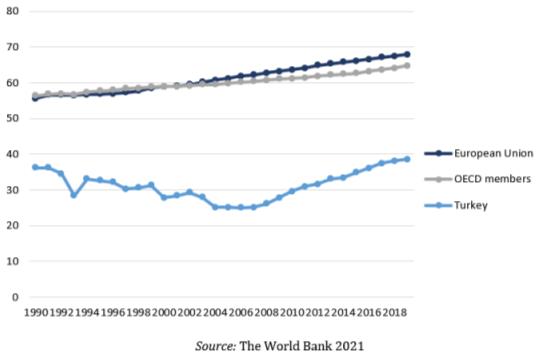
On the contrary, FLFP in the OECD and EU never decreased over those years under consideration which increased the gap with Turkey. Figure 9.6. given below illustrates the radar chart of the state of Turkey in comparison with the EU and OECD averages for FLFP over the years 1990 and 2019, where the increasing gap between the FLFP of Turkey and of the EU and OECD can be easily seen.
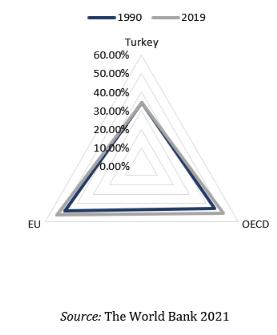
As it can be seen from Figure 9.6., Turkey has a long way in catching up with the average levels of FLFP of the EU and OECD members. It should also be noted that Turkey has the lowest FLFP rate and the lowest ratio of female to male LFP among both the OECD and EU members with considerably low figures for 2019 (The World Bank, 2021).
Main determinants of FLFP in Turkey
There are several micro and macro level factors determining the FLFP rate in the labour market; such as social, cultural and economic factors. Several studies are conducted as mentioned before aiming to find those determinants through either country specific or cross-sectional analysis. In Turkey, the main determinants of FLFP in the labour market can be divided into five main categories as fertility, education and skills, the role of housework, globalization, and lastly religious, cultural and social norms.
Fertility is considered to be one of the most important determinants of FLFP in the literature since children bearing has opportunity cost of labour market attainment (Dayioglu & Kirdar, 2010). Moreover, having children decreases FLFP since women with children tend to spend more time on childcare and household activities. Nevertheless, there are some studies in the literature suggesting that there is a positive impact of fertility on FLFP, particularly in some EU countries which provide sufficient childcare subsidies. However, in the case of Turkey, fertility still serves as a negative factor for FLFP in the labour market (Dayioglu, 2000; Dayioglu & Kirdar, 2010).
Education and skills category is the second indicator of FLFP in Turkey. In the literature, the impact of education and skills on FLFP is ambiguous. The impact of education and skills on FLFP in the labour market can be focused in two dimensions; as first the effect on decision to participate in the labour market, and second the effect on duration to divert to labour market. Concentrating on the first, education and skills positively contribute the decision of FLFP in the labour market because of two key reasons. First, education is accepted as an investment in human capital, thus, to be able to get the cost recovery of the recipient through work FLFP increaes. Second, being seen as consumption activity FLFP increases because of the opportunity cost generated by not working compared to the possible higher earning potential of working. On the other hand, the duration of FLFP is positively affected by education and skills, since education raises the potential of employment and consequently the cost of not working. Furthermore, a higher income is achieved by the earnings generated by employment. A higher income is distributed between leisure and work. Thus, the direction of the impact of education and skills in that sense depends on the share of leisure and work duration decision of the recipient. If more time is diverted for work than leisure, it can be concluded that education and skills generate a positive impact on FLFP; and if more time is diverted for leisure, it can be concluded that education and leisure generate a negative impact on FLFP. Empirical studies for the case of Turkey confirm the positive impact of education and skills on FLFP (Dayioglu, 2000; Gündüz-Hoşgör & Smits; 2008; Tansel, 2002; Varol, 2017).
The role of housework constitutes the third category determining the FLFP in Turkey. Reservation wage, which indicates the minimum wage rate that a worker is willing to work, of married women with children is higher relative to single women without children as a result of the extra housework and childcare duties. Thus, if the offered wage in the labour market is below the reservation wage, women prefer to stay out of the labour force decreasing FLFP. Since in Turkey it is well known that the average wage of female workers is significantly lower than that of the males, FLFP is negatively affected by the role of housework and childcare (Kasnakoglu & Dayioglu, 2002).
The fourth category of the determinants of FLFP in Turkey is the role of globalization and liberalization. Economic globalization is defined as the deepened integration and interaction through economic activity. As a result of globalization, the number of international institutions and multinational corporations thus global production increased, hence, FLFP is also positively affected. New jobs are generated in export oriented, free trade sectors and global factories for women. The positive impact of globalization on FLFP is confirmed by empirical evidence for the case of Turkey (Kama, 2006; Kaya, 2008; Okşak & Koyuncu, 2017).
The last category of the main determinants of FLFP in Turkey involves the effect of religion, culture and social norms. Social norms and traditions seem to be the most important factor in the last category having a negative impact on FLFP in Turkey (Atasoy, 2017; Dildar, 2015; Gedikli, 2014; Goksel, 2013; O’Neil & Bilgin, 2013). Caregiving is assigned as a female’s task for both the house and children, furthermore for elders traditionally in Turkey which discourages female participation in the labour market. Social norms and male dominance play a negative role on FLFP mostly in the urban areas of Turkey.
Conclusion and policy recommendations
This study focuses on the trends in FLFP and economic growth in Turkey over the years from 1990 to 2019 to investigate how they have changed over time. Furthermore, literature findings exploring the link between FLFP and economic growth in Turkey are focused on to examine the reasons behind the low and persistent levels of FLFP. Moreover, the FLFP and economic growth of Turkey is compared with that of the EU and OECD members to see where Turkey stands compared to them, since Turkey is a member of the OECD and a candidate member of the EU.
Since labour is the crucial input over the production process, the significance of female labour force participation on economic growth has been increasingly recognized by both academics and policy makers all over the world. There are several policies applied in different countries to increase female participation in the labour market which bore their fruits over the years. However, over the years, in this study it is observed that FLFP remains permanently low without any substantial progress. Thus, the gap between the FLFP of Turkey and both of the EU and OECD members on average increased over the years. Moreover, it is observed that though there have been improvements in the per capita GDP of Turkey over the years, the gap between the per capita GDP of Turkey and of both the EU and OECD members is also worsened. Being a member of the OECD and a candidate for the EU, Turkey needs to decrease the existing gaps of FLFP and per capita GDP. Active labour market policies are essential to increase FLFP, hence to increase the per capita GDP of Turkey.
The reasons for low levels of FLFP in Turkey are categorised in five main groups; as fertility, education and skills, the role of housework, globalization, and lastly religious, cultural and social norms. Policies should be designed to ease those categories which seem to act as barriers to female participation in Turkey’s labour market.
The impact of fertility on the participation of females in the labour market remains incomplete, since there are mixed results obtained in the literature. Fertility, according to some studies has a negative impact on FLFP, by making it more difficult for women to participate in the labour market both due to demand and supply factors. FLFP is hindered because of the inaccessibility of sufficient childcare institutions. Moreover, albeit there are childcare providers, females prefer not to participate in the labour market and but instead to look after their own children, since the reservation wage in case of Turkey is usually above the minimum wage. On the other hand, it is observed that fertility increases FLFP where childcare subsidies are provided by the governments. Thus, it can be suggested in Turkey to provide subsidies or increase and improve public childcare institutions to encourage female participation in the labour market. This can also decrease the role of housework for women, easing their access to the labour market.
There has been considerable improvement in the education of females over recent years in Turkey, having a positive impact on FLFP. However, FLFP still remains low, as it has not been long since the increase in compulsory level of education from five to eight years. The impact has thus not been experienced yet, but will arise in the following decades.
Social and cultural norms are one of the most important obstacles for females in participating in the labour market. They also have an impact on females’ education levels and on the role of housework, thus playing a role as a multiplier indicator. Policies should be designed to promote the modernization of social and cultural norms, such as by encouraging female school enrolment especially in the rural areas of Turkey, improving the curriculum in education systems, and supporting females for higher education.
In addition to the suggested policies to decrease the barriers which are categorised, it is essential to mention that the degree of FLFP and the barriers to female participation in the labour market varies according to different regions of Turkey. Policies should also be designed targeting the regional differences for the achievement of higher levels of FLFP all over Turkey. Moreover, working conditions of females should also be improved and the ongoing gender wage discrimination should be prevented. Furthermore, safer working environments should be provided and supported by legislation.
References
Altuzarra, A., Gálvez-Gálvez, C., & González-Flores, A. (2019). Economic Development and Female Labour Force Participation: The Case of EU Countries. Sustainability, 11, 1962.
Anyanwu, S. O., Adesanya, B. M., Adediji, A. M., & Adesanya, A. E. (2021). Female Labour Force Participation and Economic Growth Nexus: Evidence from Nigerian Economy. Munich Personal RePEc Archive, MPRA Paper No. 106933. https://mpra.ub.uni-muenchen.de/106933/
Atasoy, B. S. (2017). Female Labour Force Participation in Turkey: The Role of Traditionalism. The European Journal of Development Research, 29, 675–706.
Bloom, D. E., Canning, D., Fink, G., & Finlay, J. E. (2009). Fertility, female labor force participation, and the demographic dividend. Journal of Economic Growth, 14, 79-101.
Bryant, J., Jacobsen V., Bell M., & Garrett D. (2004). Labour Force Participation and GDP in New Zealand. New Zealand Treasury Working Paper, 4(7).
Budun, F. (2021). Women and Economic Development in Turkey: An Empirical Analysis. Journal of Economics, Business & Political Studies, 8(1), 64-76.
Cain, G. G. (1966). Labor Force Participation of Married Women. University of Chicago Press.
Cin, F. M., Gümüş, S., & Weiss, F. (2021). Women’s empowerment in the period of the rapid expansion of higher education in Turkey: Developments and paradoxes of gender equality in the labour market. Higher Education, 81, 31-50.
Dayioglu, M. (2000). Labour market participation of women in Turkey. In F. Acar, & A. Gunes-Ayata (Eds.), Gender and Identity Construction: Women in Central Asia, the Caucasus and Turkey (pp. 44–73). Brill.
Dayioglu, M., & Kirdar, M. G. (2010). Determinants of and Trends in Labor Force Participation of Women in Turkey. State Planning Organization of the Republic of Turkey and World Bank Welfare and Social Policy Analytical Work Program, Working Paper, Number 5.
Dildar, Y. (2015). Patriarchal norms, religion, and female labor supply: evidence from Turkey. World Development, 76, 40–61.
Dursun, G., & Damadoglu, J. (2020). Female Labour Force Participation and Economic Growth in the South Mediterranean Countries: Structural Shifts in Causal Linkages. Journal of Current Researches on Business and Economics, 10(1), 69-82.
Gaddis, I., & Klasen, S. (2014). Economic development, structural change, and women’s labour force participation. Journal of Population Economics, 27(3), 639–681.
Gedikli, C. (2014). Female Labour Supply in Turkey: Do Traditional Gender Roles Matter? In Paper Prepared for the IARIW 33rd General Conference Rotterdam, The Netherlands.
Goksel, I. (2013). Female labor force participation in Turkey: the role of conservatism. Women's Studies International Forum, 4, 45–54.
Goldin, C. (1995). The U-Shaped Female Labor Force Function in Economic Development and Economic History. In T. P. Schultz (Ed.), Investment in Women’s Human Capital. The University of Chicago Press.
Gruen, D., & Garbutt, M. (2003). The output implications of higher labour force participation. Treasury Working Paper 2003/02.
Gündüz-Hoşgör, A., & Smits, J. (2008, March). Variation in labor market participation of married women in Turkey. In Women's Studies International Forum (Vol. 31, No. 2, pp. 104-117). Pergamon.
International Monetary Fund. (2013). Women, work and the economy: Macroeconomic gains from gender equity. IMF Staff Discussion Note 13/10. Washington.
International Monetary Fund. (2016). Inequality, gender gaps and economic growth: Comparative evidence for sub-Saharan Africa. IMF Staff, Working Papers WP/16/111.
Kalmaz, D. B. (2018). Projection of the Output Cost Arising from Low Labour Force Participation of Women in North Cyprus. Kadın/Women 2000, 19(2), 17-30.
Kama, O. (2006). Human Resources, Impact of Trade Liberalization on the Gender Gap in Turkey. International Conference on Human and Economic Resources, Izmir, 23-29.
Kasnakoglu, Z., & Dayioglu M. (2002). Measuring the value of home production in Turkey. In T. Bulutay (Ed.), The New Developments in National Accounts. SIS: Ankara.
Kaya, Y. (2008). Proletarianization with polarization: Industrialization, globalization, and social class in Turkey, 1980–2005. Research in Social Stratification and Mobility, 26, 161–181.
Khaliq, A., Khan, D., Akbar, S., Hamayun, M., & Ullah, B. (2017). Female Labor Market Participation and Economic Growth: The Case of Pakistan. Journal of Social Science Studies, 4(2), 217-230.
Kumari, R. (2018). Economic growth, disparity, and determinants of female labor force participation: A research agenda. World Journal of Entrepreneurship, Management and Sustainable Development, 14(2), 138-152.
Luci, A. (2009). Female Labor Market Participation and Economic Growth. International Journal of Innovation Sustainable Development, 4(2/3), 97–108.
Mincer, J. (1962). Labour Force Participation of Married Women: A Study of Labour Supply. In H. Gregg Lewis (Ed.), Aspects of Labour Economics. National Bureau of Economic Research, Princeton University Press.
Mujahid, N., & Zafar, N. (2012). Economic Growth - Female Labour Force Participation Nexus: An Empirical Evidence for Pakistan. The Pakistan Development Review, Winter 2012, Vol. 51, No. 4; Papers and Proceedings PARTS I and II, The 28th Annual General Meeting and Conference of the Pakistan Society of Development Economists, Islamabad, November 13 - 15, 2012 (Winter 2012), 565-585. https://www.jstor.org/stable/23734787
OECD. (2008). Gender and Sustainable Development: Maximizing the Economic, Social and Environmental Role of Women. https://www.oecd.org/social/40881538.pdf
OECD. (2015). Gender equality: Why a push for gender equality makes a sound economic sense. http://www.oecd.org/gender/push-gender-equality-economic-sense.htm
OECD (2018). Sub-Saharan Africa: The social institutions and gender index (SIGI) regional report. https://www.oecd.org/dev/development-gender/Mini-Brochure _SIGI_AfriqueSubsaharienne_EN-web.pdf
OECD (2020). COVID-19: Time for gender inclusive decision-making. http://www.oecd.org/gender/push-gender-equality-economic-sense.htm
Okşak, Y., & Koyuncu, J. Y. (2017). Does globalization affect female labor force participation: Panel evidence. Journal of Economics Bibliography, 4(4), 381-387. http://www.kspjournals.org
O’Neil, M. L., & Bilgin. M. H. (2013). Religion as a factor influencing women’s decisions to work. Journal of International Women’s Studies, 14(3), 163–173.
Sinha, J. N. (1967). Dynamics of Female Participation in Economic Activity in a Developing Economy. In Proceedings of the World Population Conference Belgrade (Vol. 4, pp. 336–337).
Tam, H. (2011). U-shaped female labour participation with economic development: Some panel data evidence. Economics Letters, 110(2), 140–142.
Tansel, A. (2002). Economic development and female labour force participation in Turkey: Time-series evidence and cross-province estimates. ERC Working Papers 0105, ERC – Economic Research Center, Middle East Technical University.
Tsani, S., Paroussos, L., Fragiadakis, C., Charalambidis, I., & Capros, P. (2013). Female labour force participation and economic growth in the South Mediterranean countries. Economics Letters, 120, 323-328.
Turkiye Istatistik Kurumu (TUIK) (2021). Available at: https://data.tuik.gov.tr/Bulten/Index?p=Yillik-Gayrisafi-Yurt-Ici-Hasila-2020
Tunali, I, Kirdar, M., & Dayioglu, M. (2021). Down and up the ‘‘U” – A synthetic cohort (panel) analysis of female labor force participation in Turkey, 1988–2013, World Development, 146, 105609.
Varol, F. (2017). The Determinants of Labor Force Participation of Women in Turkey: A Binary Logit Analysis. Journal of History, Culture & Art Research, 6(2), 92-108. https://doi.org/10.7596/taksad.v6i2.564
Verick, S. (2014). Female Labor Force Participation in Developing Countries. IZA World of Labor, 87.
World Bank. (2007). Gender equality, poverty and economic growth. Policy Research working paper, WPS 4349.
World Bank. (2012). Gender equality for development. https://www.worldbank.org/en/research/dime/brief/dime-gender-program
World Bank. (2018). The World Bank in gender. https://www.worldbank.org/en/topic/gender/
World Bank. (2021). The World Bank Data. https://data.worldbank.org/indicator/NY.GDP.PCAP.CD?locations=TR
Copyright information

This work is licensed under a Creative Commons Attribution-NonCommercial-NoDerivatives 4.0 International License.
About this article
Publication Date
30 November 2022
Article Doi
eBook ISBN
978-1-80296-998-6
Publisher
European Publisher
Volume
-
Print ISBN (optional)
-
Edition Number
1st Edition
Pages
1-156
Subjects
Eastern Mediterranean, economy, politics, energy, geopolitics, security, refugee crisis, nationalism, populism, democratization
Cite this article as:
Kalmaz, D. B. (2022). Female Labour Force Participation and Economic Growth in Turkey. In M. T. Özsağlam (Ed.), Politics, Economy, Security Issues Hidden Under the Carpet of Mediterranean, vol -. (pp. 140-156). European Publisher. https://doi.org/10.15405/BI.20221101.9

